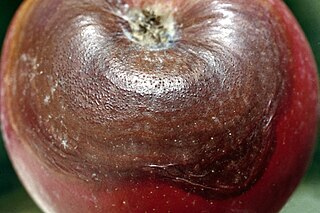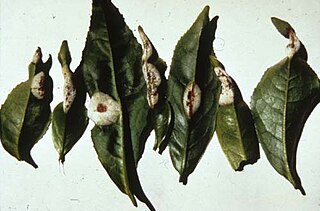Blight is a specific symptom affecting plants in response to infection by a pathogenic organism.

Fire blight, also written fireblight, is a contagious disease affecting apples, pears, and some other members of the family Rosaceae. It is a serious concern to apple and pear producers. Under optimal conditions, it can destroy an entire orchard in a single growing season.

The quince is the sole member of the genus Cydonia in the Malinae subtribe of the Rosaceae family. It is a deciduous tree that bears hard, aromatic bright golden-yellow pome fruit, similar in appearance to a pear. Ripe quince fruits are hard, tart, and astringent. They are eaten raw or processed into marmalade, jam, paste or alcoholic beverages.

Alternaria is a genus of Deuteromycetes fungi. All species are known as major plant pathogens. They are also common allergens in humans, growing indoors and causing hay fever or hypersensitivity reactions that sometimes lead to asthma. They are present in the human mycobiome and readily cause opportunistic infections in immunocompromised people such as AIDS patients.

Pseudomonas cichorii is a Gram-negative soil bacterium that is pathogenic to plants. It has a wide host range, and can have an important economical impact on lettuce, celery and chrysanthemum crops. P. cichorii was first isolated on endives, from which it derives its name. It produces 6-aminopenicillanic acid. Based on 16S rRNA analysis, P. cichorii has been placed in the P. syringae group.

Damping off is a horticultural disease or condition, caused by several different pathogens that kill or weaken seeds or seedlings before or after they germinate. It is most prevalent in wet and cool conditions.
Glomerella graminicola is an economically important crop parasite affecting both wheat and maize where it causes the plant disease Anthracnose Leaf Blight.

Botryosphaeria obtusa is a plant pathogen that causes frogeye leaf spot, black rot and cankers on many plant species. On the leaf it is referred to as frogeye leaf spot; this phase typically affects tree and shrubs. In fruit such as the apple, cranberry and quince, it is referred to as black rot, and in twigs and trunks it causes cankers.
Ceratobasidium ochroleucum is a species of fungus in the family Ceratobasidiaceae. Basidiocarps are effused and web-like and were originally described from Brazil, causing a thread blight of apple and quince trees. The fungus was subsequently reported as a leaf disease on orchard crops in North America, but since descriptions of Ceratobasidium orchroleucum vary considerably and no type specimen exists, its identity remains unclear. Roberts (1999) considered it a "nomen dubium".
Pseudopestalotiopsis theae is a plant pathogen affecting tea.

Alternaria solani is a fungal pathogen that produces a disease in tomato and potato plants called early blight. The pathogen produces distinctive "bullseye" patterned leaf spots and can also cause stem lesions and fruit rot on tomato and tuber blight on potato. Despite the name "early," foliar symptoms usually occur on older leaves. If uncontrolled, early blight can cause significant yield reductions. Primary methods of controlling this disease include preventing long periods of wetness on leaf surfaces and applying fungicides. Early blight can also be caused by Alternaria tomatophila, which is more virulent on stems and leaves of tomato plants than Alternaria solani.

Bipolaris incurvata is a plant pathogen that causes blight and leaf spots in coconut trees.
Cochliobolus victoriae is a fungal plant pathogen. It caused the disease called "victoria blight" affecting oats and similar grains.

Phomopsis obscurans is a common fungus found in strawberry plants, which causes the disease of leaf blight. Common symptoms caused by the pathogen begin as small circular reddish-purple spots and enlarge to form V-shaped lesions that follow the vasculature of the plant's leaves. Although the fungus infects leaves early in the growing season when the plants are beginning to develop, leaf blight symptoms are most apparent on older plants towards the end of the growing season. The disease can weaken strawberry plants through the destruction of foliage, which results in reduced yields. In years highly favorable for disease development, leaf blight can ultimately lead to the death of the strawberry plants. A favorable environment for the growth and development of the Phomopsis obscurans pathogen is that of high temperature, high inoculum density, a long period of exposure to moisture, and immature host tissue. In the case of disease management, a conjunction of cultural practices is the most effective way of reducing the infection.

Exobasidium vexans is a plant pathogen affecting tea.

Didymella bryoniae, syn. Mycosphaerella melonis, is an ascomycete fungal plant pathogen that causes gummy stem blight on the family Cucurbitaceae, which includes cantaloupe, cucumber, muskmelon and watermelon plants. The anamorph/asexual stage for this fungus is called Phoma cucurbitacearum. When this pathogen infects the fruit of cucurbits it is called black rot.
Alternaria helianthi is a fungal plant pathogen causing a disease in sunflowers known as Alternaria blight of sunflower.

Didymascella thujina is an ascomycete fungus in the family Helotiaceae. D. thujina causes cedar leaf blight, a leaf disease, on western red cedar and white cedar (T. occidentalis).
This article summarizes different crops, what common fungal problems they have, and how fungicide should be used in order to mitigate damage and crop loss. This page also covers how specific fungal infections affect crops present in the United States.

Northern corn leaf blight (NCLB) or Turcicum leaf blight (TLB) is a foliar disease of corn (maize) caused by Exserohilum turcicum, the anamorph of the ascomycete Setosphaeria turcica. With its characteristic cigar-shaped lesions, this disease can cause significant yield loss in susceptible corn hybrids.













